engine Lexus GX470 2007 Instrument cluster / LEXUS 2007 GX470 (OM60C64U) User Guide
[x] Cancel search | Manufacturer: LEXUS, Model Year: 2007, Model line: GX470, Model: Lexus GX470 2007Pages: 436, PDF Size: 11.52 MB
Page 108 of 436
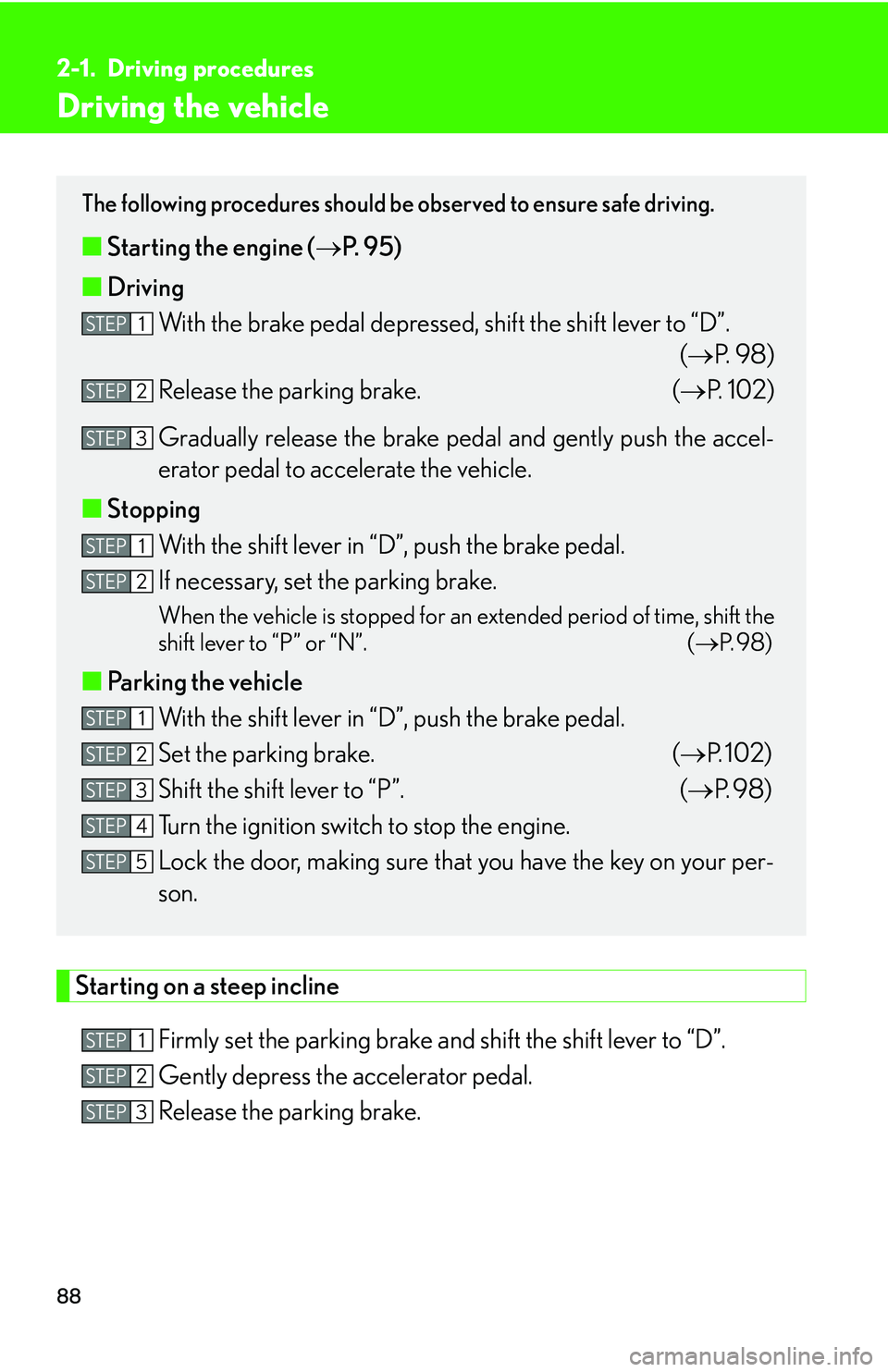
88
2-1. Driving procedures
Driving the vehicle
Starting on a steep inclineFirmly set the parking brake and shift the shift lever to “D”.
Gently depress the accelerator pedal.
Release the parking brake.
The following procedures should be observed to ensure safe driving.
■ Starting the engine ( P. 9 5 )
■ Driving
With the brake pedal depressed, shift the shift lever to “D”. (P. 9 8 )
Release the parking brake. ( P. 1 0 2 )
Gradually release the brake peda l and gently push the accel-
erator pedal to accelerate the vehicle.
■ Stopping
With the shift lever in “D”, push the brake pedal.
If necessary, set the parking brake.
When the vehicle is stopped for an extended period of time, shift the
shift lever to “P” or “N”. ( P. 9 8 )
■Parking the vehicle
With the shift lever in “D”, push the brake pedal.
Set the parking brake. ( P. 1 0 2 )
Shift the shift lever to “P”. ( P. 9 8 )
Turn the ignition switch to stop the engine.
Lock the door, making sure that you have the key on your per-
son.
STEP1
STEP2
STEP3
STEP1
STEP2
STEP1
STEP2
STEP3
STEP4
STEP5
STEP1
STEP2
STEP3
Page 110 of 436
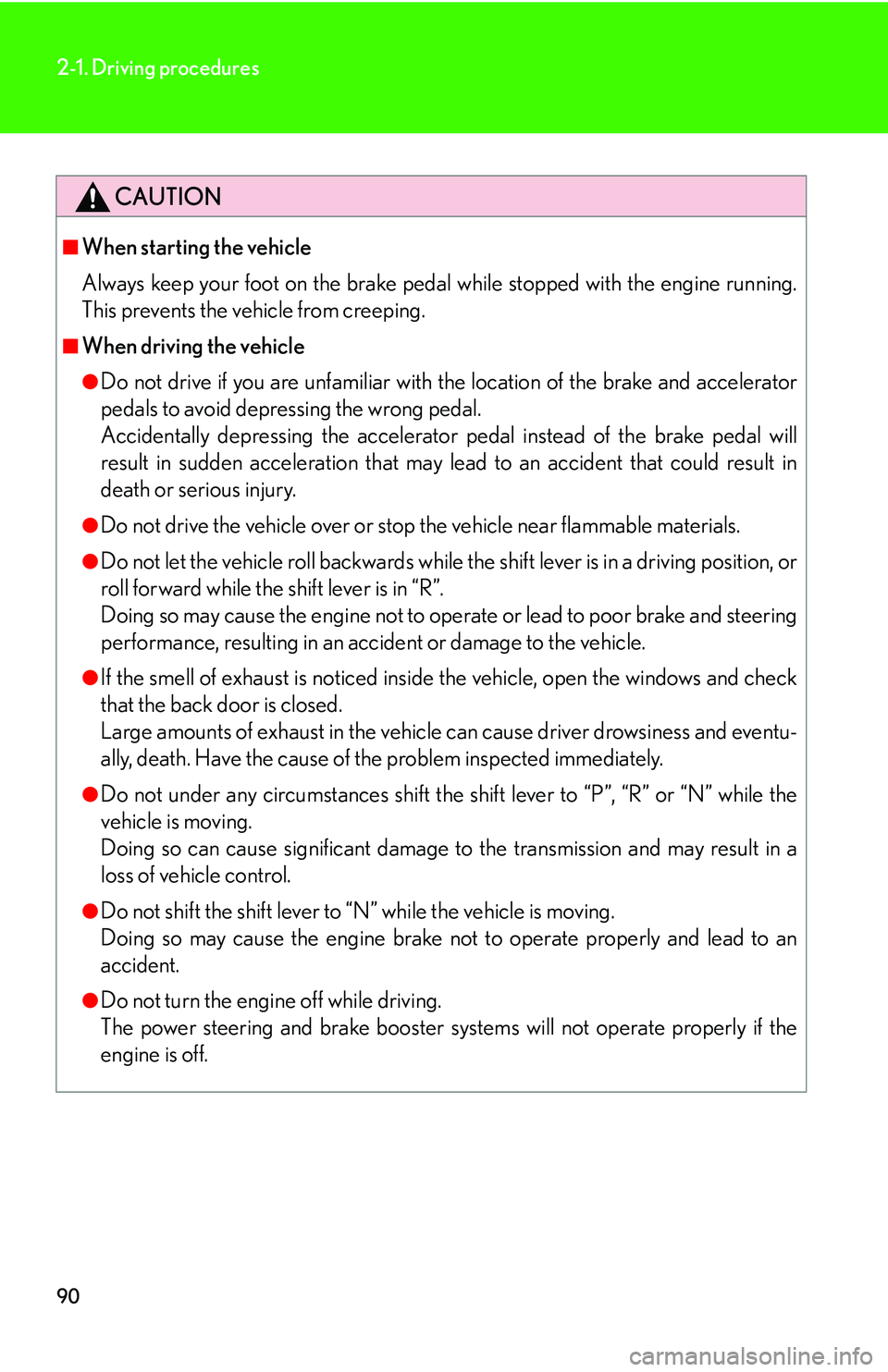
90
2-1. Driving procedures
CAUTION
■When starting the vehicle
Always keep your foot on the brake pedal while stopped with the engine running.
This prevents the vehicle from creeping.
■When driving the vehicle
●Do not drive if you are unfamiliar with the location of the brake and accelerator
pedals to avoid depressing the wrong pedal.
Accidentally depressing the accelerator pedal instead of the brake pedal will
result in sudden acceleration that may lead to an accident that could result in
death or serious injury.
●Do not drive the vehicle over or stop the vehicle near flammable materials.
●Do not let the vehicle roll backwards while the shift lever is in a driving position, or
roll forward while the shift lever is in “R”.
Doing so may cause the engine not to oper ate or lead to poor brake and steering
performance, resulting in an accident or damage to the vehicle.
●If the smell of exhaust is noticed inside the vehicle, open the windows and check
that the back door is closed.
Large amounts of exhaust in the vehicle can cause driver drowsiness and eventu-
ally, death. Have the cause of the problem inspected immediately.
●Do not under any circumstances shift the shift lever to “P”, “R” or “N” while the
vehicle is moving.
Doing so can cause significant damage to the transmission and may result in a
loss of vehicle control.
●Do not shift the shift lever to “N” while the vehicle is moving.
Doing so may cause the engine brake not to operate properly and lead to an
accident.
●Do not turn the engine off while driving.
The power steering and brake booster systems will not operate properly if the
engine is off.
Page 111 of 436
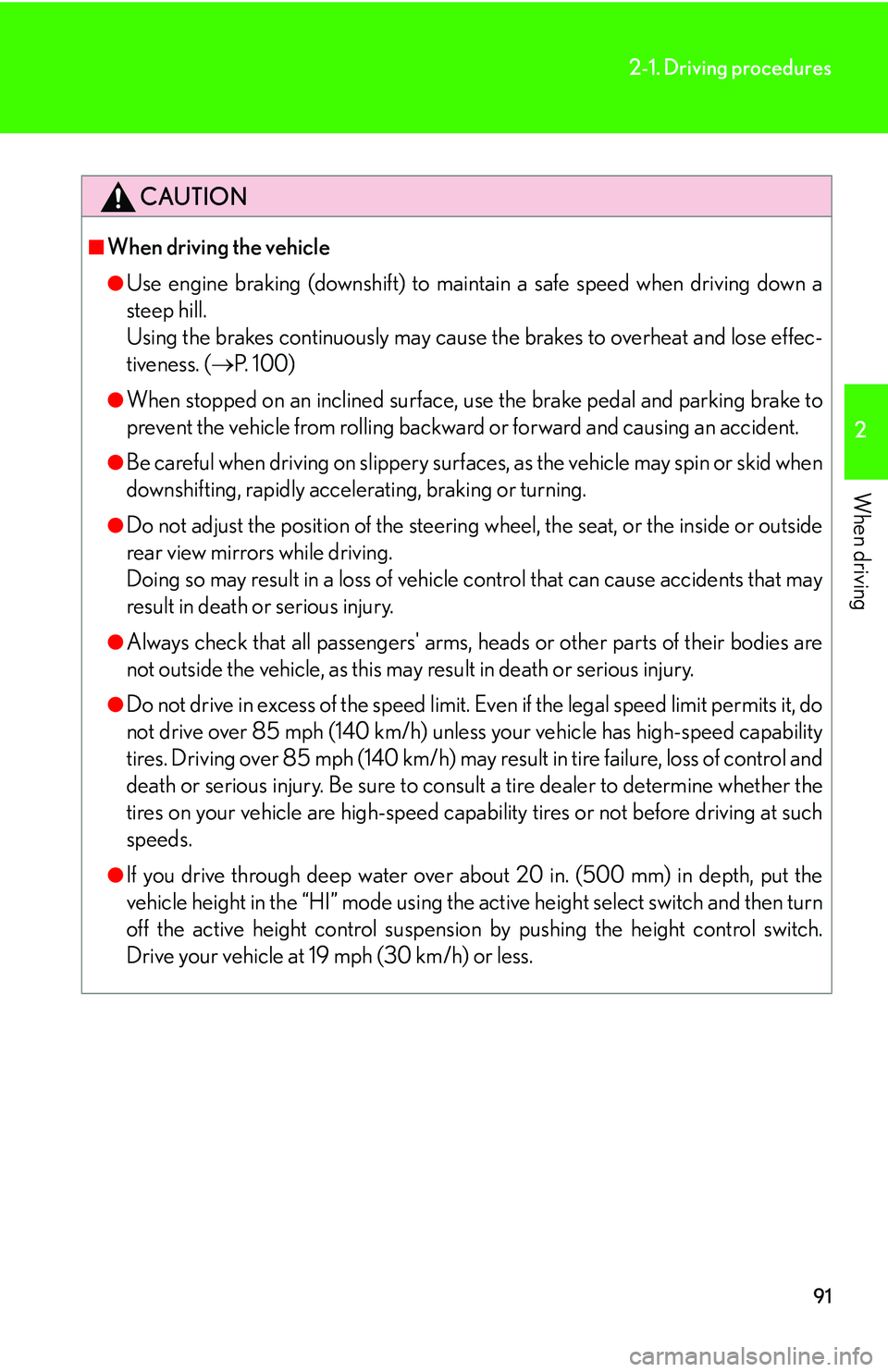
91
2-1. Driving procedures
2
When driving
CAUTION
■When driving the vehicle
●Use engine braking (downshift) to maintain a safe speed when driving down a
steep hill.
Using the brakes continuously may cause the brakes to overheat and lose effec-
tiveness. (P. 100)
●When stopped on an inclined surface, use the brake pedal and parking brake to
prevent the vehicle from rolling backward or forward and causing an accident.
●Be careful when driving on slippery surfaces, as the vehicle may spin or skid when
downshifting, rapidly accelerating, braking or turning.
●Do not adjust the position of the steering wheel, the seat, or the inside or outside
rear view mirrors while driving.
Doing so may result in a loss of vehicle control that can cause accidents that may
result in death or serious injury.
●Always check that all passengers' arms, heads or other parts of their bodies are
not outside the vehicle, as this may result in death or serious injury.
●Do not drive in excess of the speed limit. Even if the legal speed limit permits it, do
not drive over 85 mph (140 km/h) unless your vehicle has high-speed capability
tires. Driving over 85 mph (140 km/h) may result in tire failure, loss of control and
death or serious injury. Be sure to consult a tire dealer to determine whether the
tires on your vehicle are high-speed capability tires or not before driving at such
speeds.
●If you drive through deep water over ab out 20 in. (500 mm) in depth, put the
vehicle height in the “HI” mode using the active height select switch and then turn
off the active height control suspension by pushing the height control switch.
Drive your vehicle at 19 mph (30 km/h) or less.
Page 112 of 436
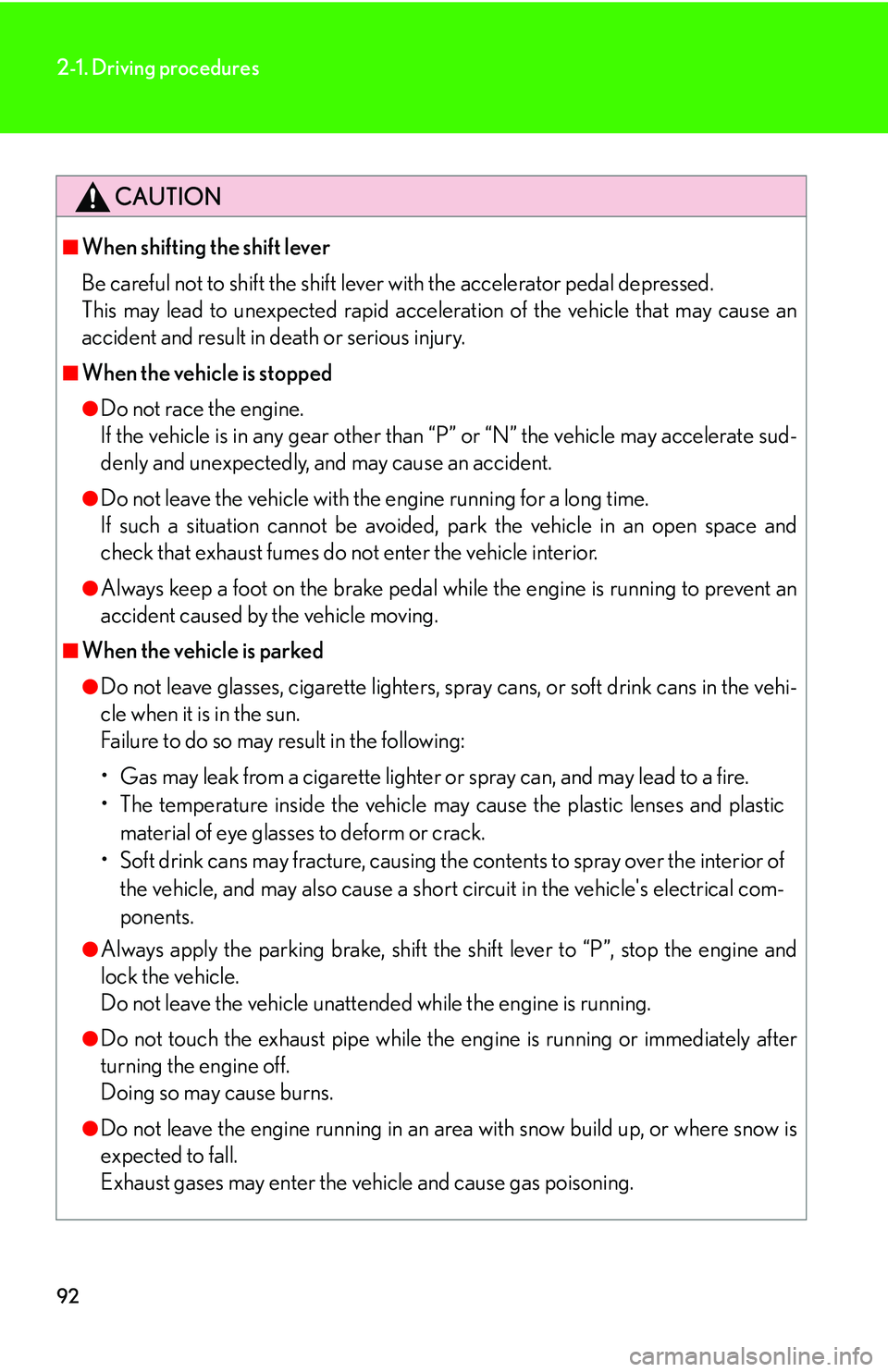
92
2-1. Driving procedures
CAUTION
■When shifting the shift lever
Be careful not to shift the shift lever with the accelerator pedal depressed.
This may lead to unexpected rapid acceleration of the vehicle that may cause an
accident and result in death or serious injury.
■When the vehicle is stopped
●Do not race the engine.
If the vehicle is in any gear other than “P” or “N” the vehicle may accelerate sud-
denly and unexpectedly, and may cause an accident.
●Do not leave the vehicle with the engine running for a long time.
If such a situation cannot be avoided, park the vehicle in an open space and
check that exhaust fumes do not enter the vehicle interior.
●Always keep a foot on the brake pedal while the engine is running to prevent an
accident caused by the vehicle moving.
■When the vehicle is parked
●Do not leave glasses, cigarette lighters, spray cans, or soft drink cans in the vehi-
cle when it is in the sun.
Failure to do so may result in the following:
• Gas may leak from a cigarette lighter or spray can, and may lead to a fire.
• The temperature inside the vehicle may cause the plastic lenses and plastic
material of eye glasses to deform or crack.
• Soft drink cans may fracture, causing the contents to spray over the interior of
the vehicle, and may also cause a short circuit in the vehicle's electrical com-
ponents.
●Always apply the parking brake, shift the shift lever to “P”, stop the engine and
lock the vehicle.
Do not leave the vehicle unattend ed while the engine is running.
●Do not touch the exhaust pipe while the engine is running or immediately after
turning the engine off.
Doing so may cause burns.
●Do not leave the engine running in an area with snow build up, or where snow is
expected to fall.
Exhaust gases may enter the vehicle and cause gas poisoning.
Page 113 of 436
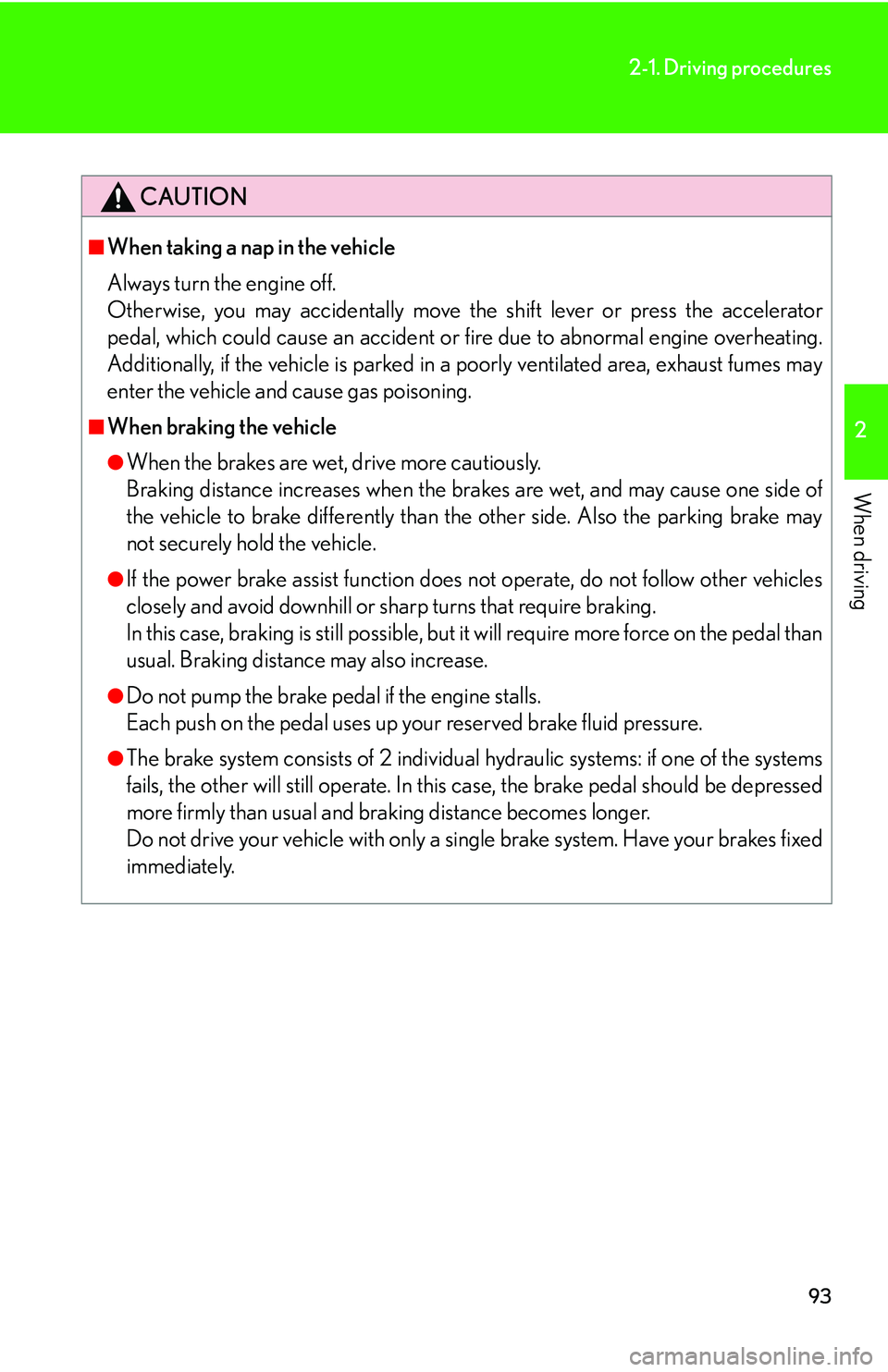
93
2-1. Driving procedures
2
When driving
CAUTION
■When taking a nap in the vehicle
Always turn the engine off.
Otherwise, you may accidentally move the shift lever or press the accelerator
pedal, which could cause an accident or fire due to abnormal engine overheating.
Additionally, if the vehicle is parked in a poorly ventilated area, exhaust fumes may
enter the vehicle and cause gas poisoning.
■When braking the vehicle
●When the brakes are wet, drive more cautiously.
Braking distance increases when the brakes are wet, and may cause one side of
the vehicle to brake differently than the other side. Also the parking brake may
not securely hold the vehicle.
●If the power brake assist function does not operate, do not follow other vehicles
closely and avoid downhill or sharp turns that require braking.
In this case, braking is still possible, but it will require more force on the pedal than
usual. Braking distance may also increase.
●Do not pump the brake pedal if the engine stalls.
Each push on the pedal uses up yo ur reserved brake fluid pressure.
●The brake system consists of 2 individual hydraulic systems: if one of the systems
fails, the other will still operate. In this case, the brake pedal should be depressed
more firmly than usual and braking distance becomes longer.
Do not drive your vehicle with only a single brake system. Have your brakes fixed
immediately.
Page 115 of 436
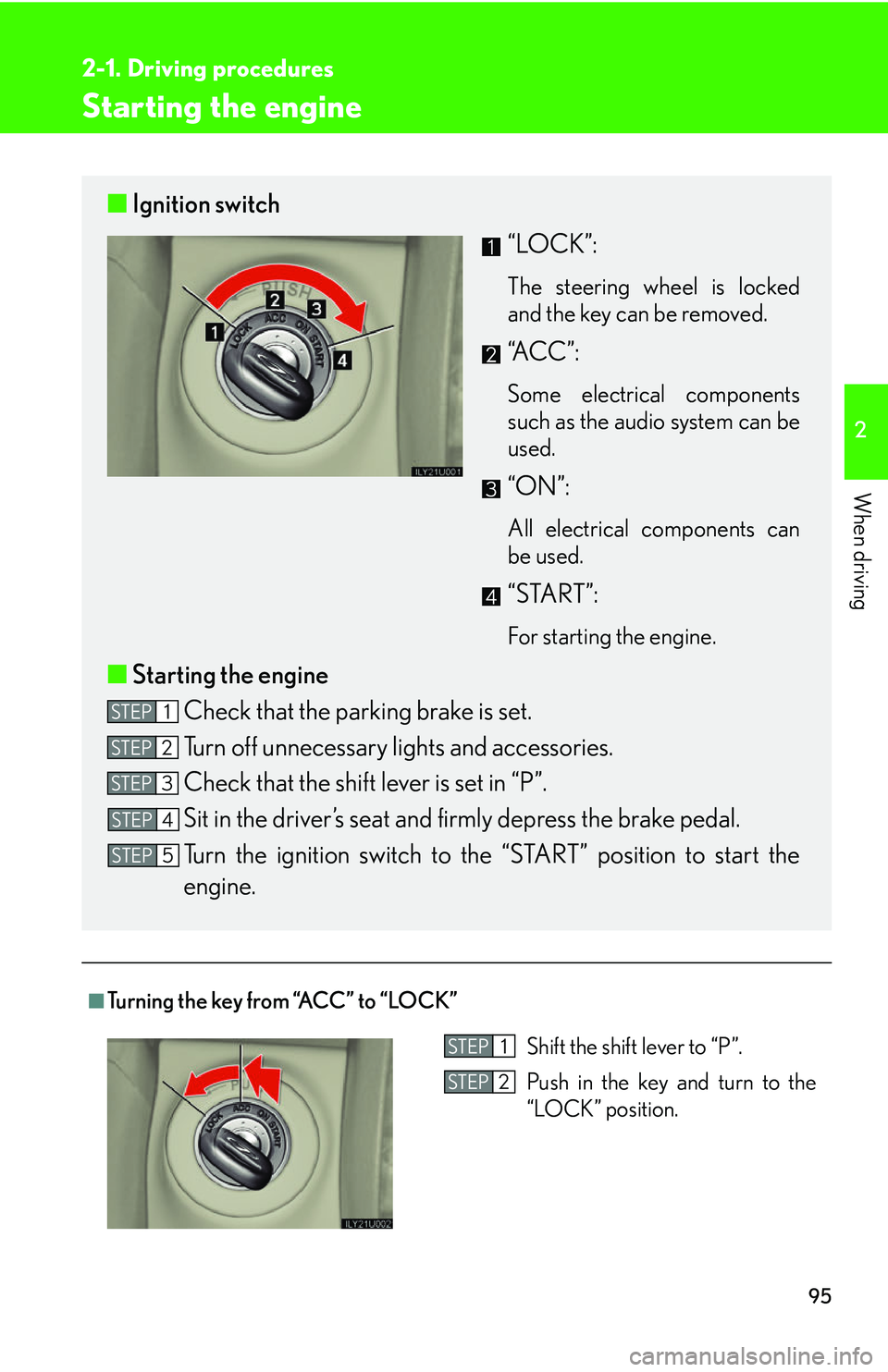
95
2-1. Driving procedures
2
When driving
Starting the engine
■Turning the key from “ACC” to “LOCK”
■Ignition switch
“LOCK”:
The steering wheel is locked
and the key can be removed.
“A C C ” :
Some electrical components
such as the audio system can be
used.
“ON”:
All electrical components can
be used.
“START”:
For starting the engine.
■Starting the engine
Check that the parking brake is set.
Turn off unnecessary lights and accessories.
Check that the shift lever is set in “P”.
Sit in the driver’s seat and firmly depress the brake pedal.
Turn the ignition switch to the “START” position to start the
engine.
STEP1
STEP2
STEP3
STEP4
STEP5
Shift the shift lever to “P”.
Push in the key and turn to the
“LOCK” position.STEP1
STEP2
Page 116 of 436

96
2-1. Driving procedures
■Steering lock release
■Starting the engine using the flat keyPut the key case away when the security indicator light goes out. This
means the engine immobilizer system has turned off.
Start the engine within 60 seconds after the security indicator light goes
off.
■Leak detection pump
Several hours after the engine is turned off, you may hear a sound coming from
underneath the luggage compartment for several minutes. This is normal operation
and does not indicate a malfunction.
When starting the engine, the ignition switch
may seem stuck in the “LOCK” position. To
free it, turn the ignition key while turning the
steering wheel slightly in either direction.
Remove the flat key from its case. Insert the
key into the ignition switch.STEP1
Bring the key case close to the ignition switch
within 10 seconds as indicated by an arrow.STEP2
STEP3
STEP4
Page 117 of 436
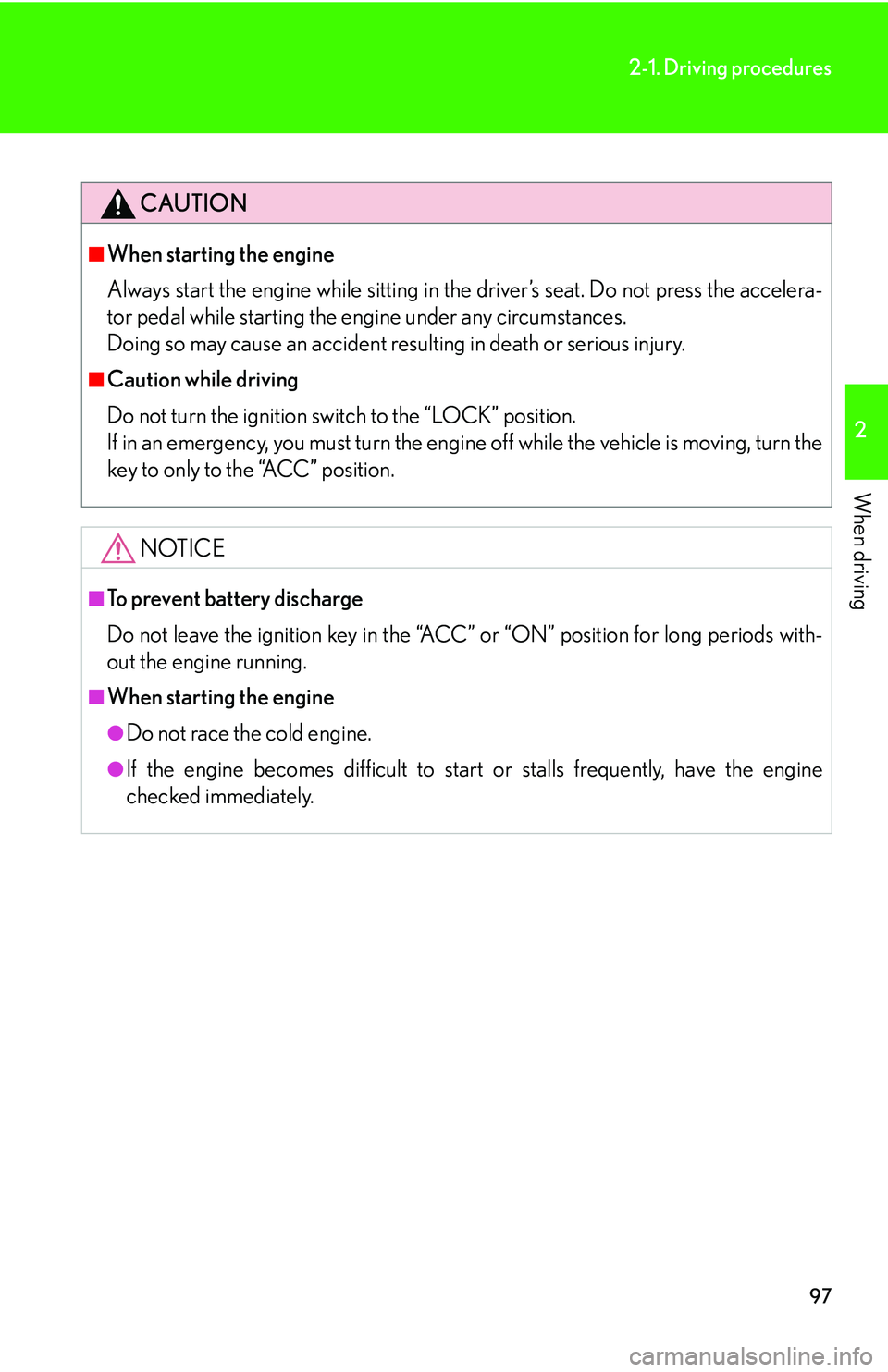
97
2-1. Driving procedures
2
When driving
CAUTION
■When starting the engine
Always start the engine while sitting in the driver’s seat. Do not press the accelera-
tor pedal while starting the engine under any circumstances.
Doing so may cause an accident resu lting in death or serious injury.
■Caution while driving
Do not turn the ignition switch to the “LOCK” position.
If in an emergency, you must turn the engi ne off while the vehicle is moving, turn the
key to only to the “ACC” position.
NOTICE
■To prevent battery discharge
Do not leave the ignition key in the “ACC” or “ON” position for long periods with-
out the engine running.
■When starting the engine
●Do not race the cold engine.
●If the engine becomes difficult to start or stalls frequently, have the engine
checked immediately.
Page 119 of 436

99
2-1. Driving procedures
2
When driving
■Shift position uses
*: To improve fuel consumption and reduce noises, set the shift lever in the
“D” position for normal driving.
■ Selecting second start mode
Use the second start mode for a ccelerating and driving on slippery
road surfaces, such as on snow.
Press the “2nd STRT” switch.
To cancel the mode, press the
switch again.
Shift positionFunction
PParking the vehicle or starting the engine
RReversing
NNeutral
DNormal driving*
4Position for moderate engine braking
3, 2Position for more powerful engine braking
LPosition for maximum engine braking
Page 120 of 436
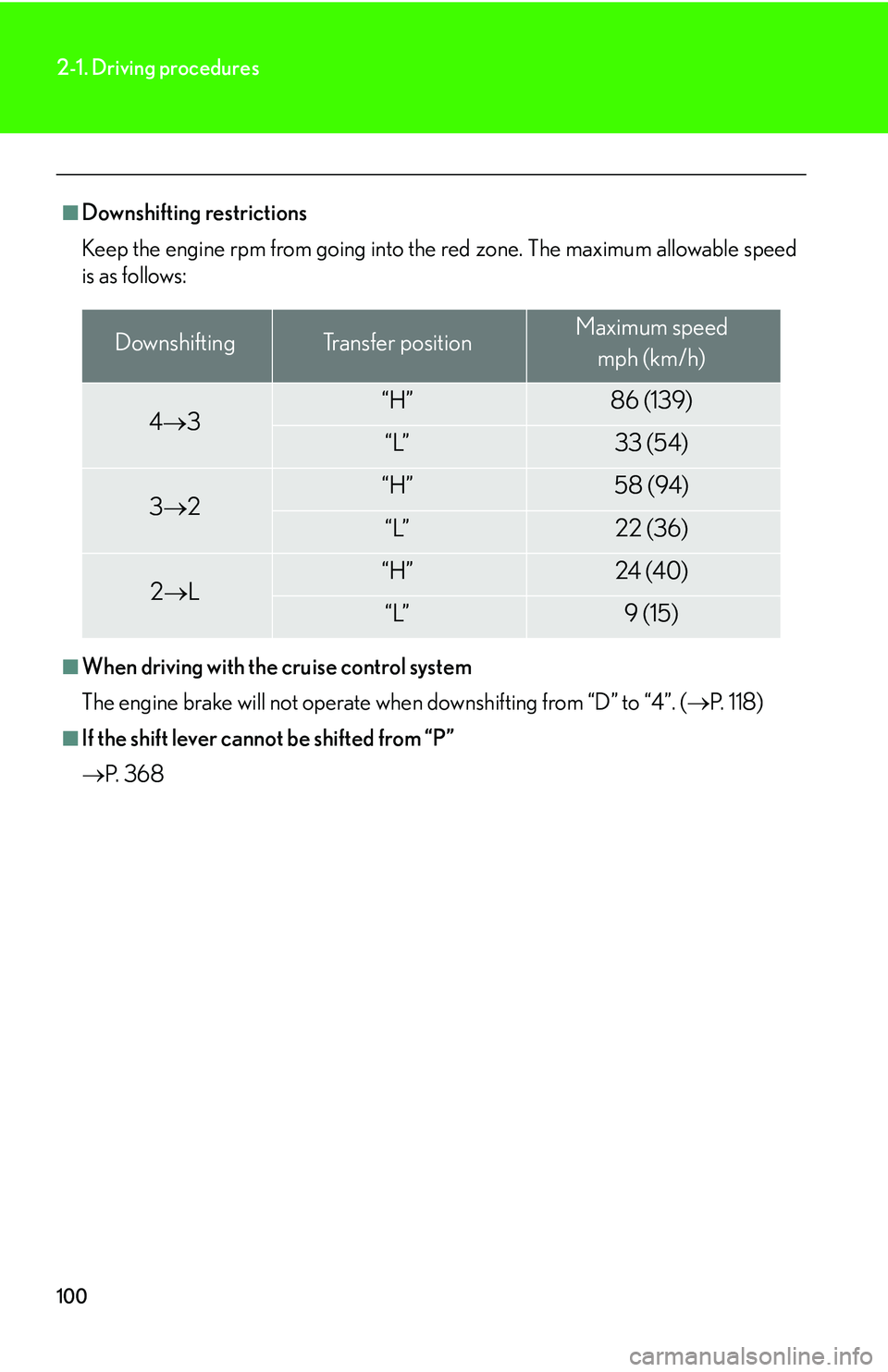
100
2-1. Driving procedures
■Downshifting restrictions
Keep the engine rpm from going into the red zone. The maximum allowable speed
is as follows:
■When driving with the cruise control system
The engine brake will not operate when downshifting from “D” to “4”. (P. 1 1 8 )
■If the shift lever cannot be shifted from “P”
P. 3 6 8
DownshiftingTr a n s f e r p o s i t i o nMaximum speed
mph (km/h)
4 3“H”86 (139)
“L”33 (54)
3 2“H”58 (94)
“L”22 (36)
2 L“H”24 (40)
“L”9 (15)